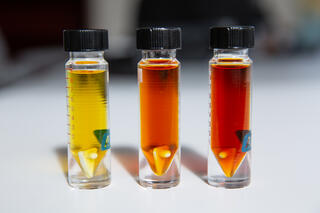Production of 5-hydroxymethylfurfural from biomass-derived carbohydrates

A cost-effective, industry-ready process for making the valuable platform chemical 5-hydroxymethylfurfural (HMF).
The Science
Scientists at the Great Lakes Bioenergy Research Center (GLBRC) have developed an efficient and economically feasible process for producing 5-hydroxymethylfurfural (HMF), a versatile plant-derived platform chemical, from fructose using an inexpensive solvent system comprised of acetone and water. Techno-economic analysis (TEA) shows that the process would require low capital investment and could be easily integrated with the current process for high fructose corn syrup (HFCS) production. Additionally, the same solvent system can be used to convert glucose, a more abundant and less expensive carbohydrate, to HMF in a two-step process.
The Impact
Developing renewable, plant-based alternatives for petroleum-derived chemicals is a major piece of the effort to transition away from a fossil-fuel based economy toward a more sustainable and environmentally friendly bio-based economy.
This formidable challenge requires the development of new technologies and processes that are cost-competitive, require low capital investment, and produce high-value products. GLBRC scientists have developed a new process for production of HMF – a high-value product that can be used to make a wide range of chemicals, polymers, and biofuels – that meets these requirements. The process is simple and compatible with the existing infrastructure in the HFCS industry, providing an opportunity for near-term implementation. In addition, this new process can be modified to use glucose as feedstock, allowing it to be integrated with biorefineries which produce a stream of glucose from lignocellulosic biomass.
Summary
In this paper, GLBRC scientists report production of HMF from biomass-derived fructose or glucose at high yields (>90%) and with excellent carbon balance (>95%) using an inexpensive solvent system composed of acetone and water. Additionally, they show that HMF can be easily separated with high recovery (96%) and purity (~99%). TEA shows that using fructose as the feedstock requires low initial capital investment and produces HMF at minimum selling price (MSP) of $1710/ton. Further, HMF production from fructose could be easily integrated into the existing high fructose corn syrup production process, which reduces risk. Converting glucose to HMF requires an extra processing step and additional infrastructure, but using glucose as a feedstock is desirable as it is more abundant and cheaper than fructose, leading to an MSP of $1460/ton. The authors propose that initial chemical plants can be constructed to operate using fructose as feedstock, where low capital is required. Thereafter, as the process generates revenue, future chemical plants can be developed to change the feedstock to glucose to increase overall revenue
Program Manager
N. Kent Peters
kent.peters@science.doe.gov, 301-903-5549
Corresponding Author
James A. Dumesic
608-262-1095, jdumesic@wisc.edu
Funding
This material is based upon work supported by the Great Lakes Bioenergy Research Center, U.S. Department of Energy, Office of Science, Office of Biological and Environmental Research under award number DE-SC0018409.
Publications
A.H. Motagamwala, et al., “Solvent system for effective near-term production of hydroxymethylfurfural (HMF) with potential for long-term process improvement.” Energy & Environmental Science (2019). [DOI: 10.1039/C9EE00447E]
Related Links
https://pubs.rsc.org/en/content/articlehtml/2019/ee/c9ee00447e
https://news.wisc.edu/industry-ready-process-makes-plastics-chemical-from-plant-sugars/